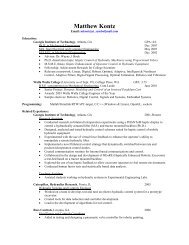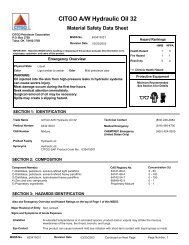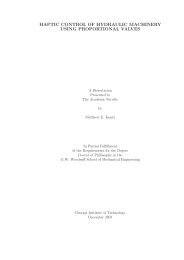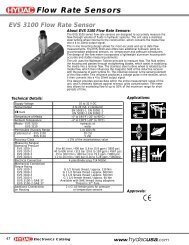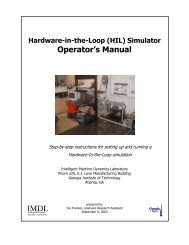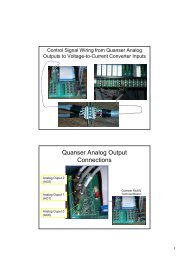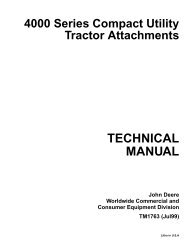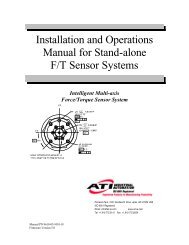PVG 32 Proportional Valves Technical Information
PVG 32 Proportional Valves Technical Information
PVG 32 Proportional Valves Technical Information
You also want an ePaper? Increase the reach of your titles
YUMPU automatically turns print PDFs into web optimized ePapers that Google loves.
<strong>PVG</strong> <strong>32</strong> <strong>Proportional</strong> Valve<br />
<strong>Technical</strong> <strong>Information</strong><br />
Function<br />
PVBS,<br />
MAIN SPOOLS FOR FLOW<br />
CONTROL (STANDARD)<br />
When using standard flow control spools, the pump pressure is determined by the<br />
highest load pressure. This is done either via the pressure adjustment spool in open<br />
centre PVP (fixed displacement pumps) or via the pump regulator (variable displacement<br />
pumps).<br />
In this way the pump pressure will always correspond to the load pressure plus the<br />
stand-by pressure of the pressure adjustment spool or the pump regulator.<br />
This will normally give optimum and stable adjustment of the oil flow.<br />
PVBS,<br />
MAIN SPOOLS<br />
FOR FLOW CONTROL<br />
(WITH LINEAR<br />
CHARACTERISTIC)<br />
PVBS main spools with linear characteristic have less dead band than standard spools<br />
and a completely proportional ratio between control signal and oil flow in the range<br />
beyond the dead band. PVBS with linear characteristic must never be used together with<br />
PVEM electrical actuators. The interaction between the small dead band of the spools<br />
and the hysteresis of the PVEM actuator of 20% involves a risk of building up a LS<br />
pressure in neutral position.<br />
PVBS,<br />
MAIN SPOOLS FOR<br />
PRESSURE CONTROL<br />
In a few systems load sensing pump<br />
pressure may result in unstable adjustment<br />
of the oil flow and a tendency<br />
towards system hunting. This may be the<br />
case with working functions that have a<br />
large moment of inertia or over-centre<br />
valves. In such systems main spools for<br />
pressure control can be advantageous.<br />
The spools are designed in such a way<br />
that the pump pressure is controlled by<br />
the spool travel. The main spool must be<br />
displaced until the pump pressure just<br />
exceeds the load pressure before the working function is applied. If the main spool is<br />
held in this position, the pump pressure will remain constant – even if the load pressure<br />
changes – giving a stable system.<br />
The use of pressure control spools, however, also means that<br />
• the oil flow is load dependent<br />
• the dead band is load dependent<br />
• the pump pressure can exceed the load pressure by more than is usual.<br />
Due to these factors it is recommended that pressure control spools are only used when<br />
it is known for certain that problems with stability will arise – or already have arisen.<br />
10 520L0344



